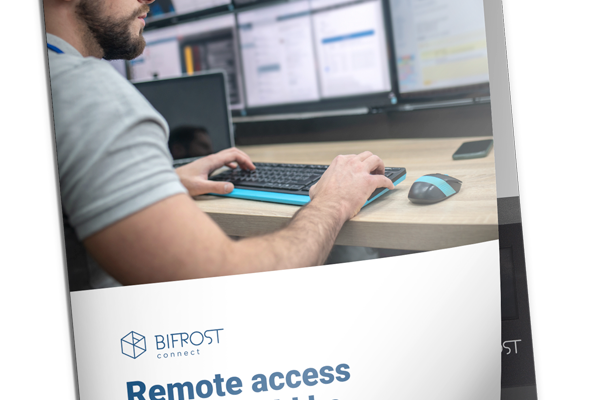BifrostConnect Blog
BifrostConnect's Blog
Remote Access Technologies: Choosing the Right Tool for IT & OT
Table of Contents
Remote access technology has evolved significantly over the years, adapting to a world where more devices than ever are connected online, and cybersecurity threats are on the rise. Traditionally designed for office IT environments, these tools have gradually integrated into operational technology (OT) spaces, linking through corporate networks. Today, we see a diverse mix of remote access solutions, each with unique strengths and challenges.
In this blog, we'll explore the various types of remote access, their advantages and limitations, and why comparing them directly is not always straightforward. Keep in mind that specific features offered by vendors and their unique implementations can make it challenging to generalize these tools uniformly.
Traditional VPN (Virtual Private Network)
A VPN (Virtual Private Network) provides secure access to corporate networks and resources over the Internet by creating a secure and encrypted connection between a user's device and a server. This connection allows for private and protected data transmission as if the devices were directly connected to a private network. It uses strong encryption and authentication methods to protect data while it is transmitted, making VPNs scalable and suitable for large enterprise deployments.
IT and OT compatibility
While VPNs are invaluable tools in IT for securing network traffic, in Operational Technology (OT) environments, they are often viewed as too permanent and may lack sufficient control.
Pros:
- Scalability: Offers flexible and scalable connectivity options, integrating both software and hardware solutions.
- Network Access: Provides network access for remote workers, facilitating continuous connectivity.
- Interconnection of Sites: Can interconnect sites or offices in various geographical areas.
Cons:
- Lateral movement: Without proper firewalls and network segregation, it may introduce a risk of lateral movement across the network, increasing security risks.
- Attack Surface: If implemented as an “always on” solution, it can create a permanent attack surface.
- Hardware/Software Requirements: May require the installation of dedicated hardware or software on client devices.
- Complexity: Can be complex to set up and manage, particularly for remote users; managing certificates can add to the complexity.
- Performance: May introduce latency and performance issues, especially in bandwidth-intensive applications.
- Third-party availability: Third-party technicians might face challenges installing VPN clients on end customers’ computers due to conflicts with other active VPNs or compliance policies.
- On-site control: On-site users often lack control over who has access and visibility into who has accessed the system. This can lead to frustration and uncertainty, especially if the endpoint(s) contains personal, sensitive data or is mission-critical to operations.
Remote Access Software
Remote Access Software provides a user-friendly solution for connecting to desktops, servers, and mobile devices with an internet connection. It's designed to be easy to set up and use, often requiring minimal technical expertise, making it accessible for personal and business applications.
IT and OT compatibility
Remote Access Software offers a robust range of IT applications in office environments. In OT, it can be effectively utilized in scenarios like Jumpstations or Engineering stations. However, it wasn't originally designed with OT environments in mind and often fails to meet specific OT needs such as time-based access or PLC tunneling. This limitation can restrict its usefulness in OT settings where specialized controls and strict access management are essential.
Pros:
- Availability: Can be downloaded online, offering instant scalability to meet the needs of various users and applications.
- Performance: Generally provides a fast and efficient remote access experience, minimizing latency and enhancing productivity.
Cons:
- Installation Requirements: Needs to be installed and regularly updated on your operating system, which can be time-consuming and requires ongoing maintenance.
- Client Requirements: Requires a client to be installed at the remote end, which can complicate setup and access.
- Security Features: May lack some of the advanced security features found in enterprise-grade solutions, potentially limiting its use in highly sensitive environments.
- Vulnerabilities: If not properly configured and secured, it can be vulnerable to security risks, exposing users and data to potential threats.
- On-site control: On-site users often lack control over who has access and visibility into who has accessed the system. This can lead to frustration and uncertainty, especially if the endpoint(s) contains personal, sensitive data or is mission-critical to operations.
Privileged Access Management (PAM) solutions
Privileged Access Management (PAM) solutions are integrated into the organization’s IT infrastructure, providing a centralized system for managing and monitoring privileged accounts. Equipped with robust security features, including strict access controls, comprehensive session monitoring, and advanced authentication mechanisms, PAM systems enforce the principle of least privilege. This approach helps organizations adhere to regulatory requirements and reduce the risk of security breaches, enhancing overall operational security and compliance.
IT and OT compatibility
While PAM solutions can be adapted for both IT and OT environments, they generally require servers to be installed and connected to all OT endpoints, which can be challenging. Consequently, PAM solutions are generally considered more suitable for IT than OT, as integration may not seamlessly align with the operational requirements and infrastructure.
Pros:
- Enhanced Security: Provides robust security features, including strict access controls and comprehensive session monitoring.
- Regulatory Compliance: Helps organizations meet regulatory requirements by enforcing the principle of least privilege.
- Centralized Management: Offers centralized control and management of privileged access within an organization.
- Reduced Risk of Breaches: Significantly decreases the risk of security breaches by managing and monitoring privileged account activities.
- Audit and Oversight: Enables detailed auditing and real-time oversight of user activities, enhancing transparency and accountability.
Cons:
- Complexity: Can be complex to set up and manage, especially across large and diverse IT environments.
- Cost: Often requires significant investment in terms of both initial setup and ongoing maintenance.
- Integration Challenges: May face compatibility issues with existing IT infrastructure or difficulties connecting to all required endpoints.
- User Resistance: Implementation can meet resistance from users due to changes in access and workflow processes.
- Performance Impact: Can sometimes impact system performance, particularly when implementing extensive monitoring and controls.
- Limited Offline Support: Does not support access to offline endpoints, which limits functionality in environments without continuous network connectivity.
Industrial Remote Access Gateways
Industrial Remote Access Gateways provides a specialized and secure method for remote access specifically designed for industrial environments. These solutions are tailored to meet the distinct needs of industrial control systems (ICS) and operational technology (OT) devices, offering features like protocol translation and device monitoring. With Box Solutions, users can securely manage and troubleshoot industrial equipment from virtually anywhere without the risk of exposing the systems to external threats.
IT and OT compatibility
While Industrial Remote Access Gateways are almost exclusively designed for Operational Technology (OT) environments and unsuitable for IT, they present unique challenges regarding ownership and control. A significant issue with Industrial Remote Access Gateways lies in determining who controls these boxes within the end user's network. This can lead to concerns about network security and governance, as clear management and oversight are crucial for maintaining the integrity and security of the systems.
Pros:
- OT-Specific Design: Specifically engineered for Operational Technology environments, enhancing compatibility and effectiveness.
- Secure Remote Access: Provides robust security features for safely managing and troubleshooting industrial equipment remotely.
- Protocol Translation: Includes built-in capabilities to handle various industrial protocols, facilitating seamless device communication.
- Device Monitoring: Allows for real-time monitoring of industrial devices, aiding in preventive maintenance and rapid response to issues.
- Industrial-Grade Build: Designed with industrial standards in mind, including DIN mount compatibility and 24V operation, making it suitable for harsh industrial environments.
Cons:
- IT Compatibility: Primarily designed for OT environments, often not suitable for standard IT applications.
- OT Compatibility: May have limitations when interfacing with certain types of industrial equipment or protocols.
- Configuration: Can be challenging to configure, particularly for non-IT personnel, adding to operational complexity.
- Access Control: Challenges in determining who manages and controls the boxes within the end user's network.
- Implementation: May require specific industrial knowledge for installation and setup, increasing complexity.
- Cost: Typically involves a higher initial investment than other remote access solutions.
- Physical Space Requirements: Physical space is needed for installation, which may not be readily available in all industrial settings.
BifrostConnect Remote Access
BifrostConnect is a portable, clientless hardware solution that enables point-to-point remote access to both IT and OT equipment. Its portable design allows users to provide direct remote access on an ad-hoc basis, making it ideal for third-party remote access. Built on Zero Trust principles, it combines Least Privilege access with Zero Internet Exposure, ensuring that endpoints remain isolated from the internet during remote access. When implemented as an out-of-band solution, all communication can be facilitated via LTE, ensuring that remote access is isolated from the company's main network. This enhances security and reduces the risk of network intrusion. This approach provides organizations with a tool that complements primary access solutions, such as PAM, by eliminating the need for insecure workarounds whenever the primary solution fails to provide the required access.
IT and OT compatibility
While BifrostConnect Remote Access works well for all types of IT and OT equipment, its physical design makes it especially ideal for standalone OT equipment, jump and engineering stations, and IT infrastructure like networks and servers. In contrast, IT in office environments is often faster and easier to access using software or network-centric solutions.
Pros:
- Portable: Small form factor and built-in battery allow users to easily move remote access to a single endpoint or a network of endpoints as needed.
- Secure: Built on Zero Trust principles, ensuring Least Privileges, Access Control, and Audit Log.
- Versatile: A wide variety of I/O options enable connections to an extensive range of devices.
- Clientless: Plug-and-play solution requiring no software installation on the endpoint, network, or technician's computer.
- Out-of-Band: Built-in LTE connection ensures remote access is isolated from the company network.
- Offline: Whether utilizing LTE, WiFi, or LAN, the internet connection is not shared with the endpoint and will remain offline during remote access.
Cons:
- Scalability: As a hardware-based solution, it is not as quick to implement as downloadable software.
- Protocol Translation: Lacks built-in capabilities to handle specific industrial protocols out of the box.
- Cost: Typically involves a higher initial investment compared to VPN and software-based remote access solutions.
- Physical Requirements: Requires physical space and available I/O ports for implementation, which may not be readily available in all industrial settings.
Conclusion
Remote access technology is vital for both IT and OT environments, with each solution offering unique benefits and challenges. VPNs provide robust security for IT but can be inflexible for OT. Remote Access Software is user-friendly but may lack specialized controls needed for industrial applications. PAM solutions offer secure management of privileged accounts but can be complex and costly. Industrial Remote Access Gateways are ideal for OT but present control and implementation challenges. BifrostConnect takes a complementary approach with its portable, clientless hardware design, offering secure, point-to-point remote access for both IT and OT, particularly when traditional solutions fall short.
Choosing the right solution depends on your organization's specific needs, balancing security, efficiency, and flexibility.
Table of Contents

Jesper Nisted Milvertz
Senior Solution Architect
at BifrostConnect
- Remote Access
- Reading Time: 8 mins
Discover How You Can Establish Zero Trust Access to Your Equipment
Get in touch with one of our experts today.Explore related resources
Zero Trust Access Test
February 15, 2020Is your organization equipped with the necessary tools to ensure your perimeter security remains intact during remote access?
Solution Brief: IP Tunnel
May 1, 2023How to take critical OT infrastructure offline while boosting remote access capabilities through air-gapped IP communication.
Discover BifrostConnect
May 1, 2023Zero Trust Access boosts remote work, expands market reach, saves resources, and prolongs technology lifespan.



